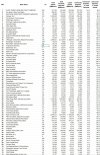From LinkedIn:
Large Banks with Large Exposures to Uninsured Deposits (Q2 2025 Version)
Below is a screen showing the 74 banks with total assets greater than $10 billion (out of 157 total) and where the ratio of uninsured deposits to total deposits is greater than 40 % as of June 30, 2025.
2024's first failed bank (Republic First of PA) was only #87 on my Q4 2023 list at 51.5 %, so (most) all of the banks on this list are at serious risk of a depositor run should they exhibit any weakness, as from CRE exposures or unrealized losses on securities. Each of the three large banks that failed during 2023 (Silicon Valley, Signature, and First Republic) relied heavily on uninsured deposits, which ran as problems emerged at each bank. Any bank that relies heavily on uninsured deposits is at risk of a liquidity crisis should any material weaknesses become public or should they seek to raise new equity capital.
Eight banks with more than $100 billion in assets are above 50%.
- State Street Bank ($372 billion): 101.5 %. (This is what they reported.)
- Bank of NY Mellon ($356 billion): 94.3 %.
- Citibank ($1.834 trillion): 80.4 %.
- Northern Trust ($170 billion): 78.4 %.
- HSBC Bank ($170 billion): 68.8 %.
- JP Morgan Chase ($3.789 trillion): 57.4 %.
- BMO Bank (254 billion): 50.4%
- U.S. Bank ($671 billion): 50.3%
An additional nine banks with more than $50 billion in assets are above 50%.
- UMB Bank ($71 billion): 67.4 %
- CIBC Bank ($60 billion): 64.6 %.
- City National Bank ($94 billion): 60.9. %.
- Banco Popular ($61 billion): 58.5 %.
- BOKF ($51 billion): 53.6 %
- East West Bank ($78 billion): 52.2 %.
- Comerica Bank ($78 billion): 52.6 %
- Synovus Bank ($61 billion): 51.1 %
- Frost Bank ($51 billion): 50.8 %
Also shown is each bank’s uninsured deposits as a percentage of liquid assets (cash plus investment securities). Banks with ratios greater than 100 % are at high risk from a run by uninsured depositors. I will be posting a list ranked by this measure shortly.
It is important to note that several of the banks on this list, such as BoNY, State Street, and Northern Trust, are so-called "trust" banks that have a very different business model from most other banks that leads them to rely almost entirely on uninsured deposits, but this will not protect them if there is any reason to lose confidence in their capital adequacy, asset quality or liquidity.
These statistics are based upon my calculations using publicly available Call Report data downloaded from the FFIEC's Central Data Repository as of Aug. 15, 2025. Source:
https://lnkd.in/et4jMyNA
Many more posts on other banking data during next few weeks.
Most of these lists will be available for download at FAU's Banking Initiative Website:
https://lnkd.in/eA8hsQuu


